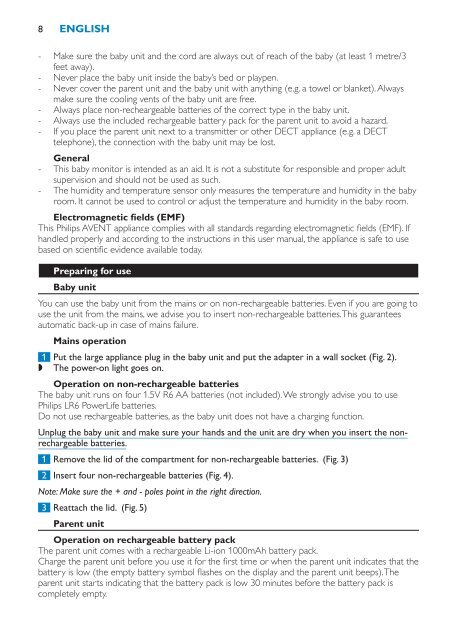Philips Avent DECT baby monitor - User manual - HUN
Philips Avent DECT baby monitor - User manual - HUN
Philips Avent DECT baby monitor - User manual - HUN
You also want an ePaper? Increase the reach of your titles
YUMPU automatically turns print PDFs into web optimized ePapers that Google loves.
8<br />
English<br />
--<br />
Make sure the <strong>baby</strong> unit and the cord are always out of reach of the <strong>baby</strong> (at least 1 metre/3<br />
feet away).<br />
--<br />
Never place the <strong>baby</strong> unit inside the <strong>baby</strong>’s bed or playpen.<br />
--<br />
Never cover the parent unit and the <strong>baby</strong> unit with anything (e.g. a towel or blanket). Always<br />
make sure the cooling vents of the <strong>baby</strong> unit are free.<br />
--<br />
Always place non-recheargeable batteries of the correct type in the <strong>baby</strong> unit.<br />
--<br />
Always use the included rechargeable battery pack for the parent unit to avoid a hazard.<br />
--<br />
If you place the parent unit next to a transmitter or other <strong>DECT</strong> appliance (e.g. a <strong>DECT</strong><br />
telephone), the connection with the <strong>baby</strong> unit may be lost.<br />
General<br />
--<br />
This <strong>baby</strong> <strong>monitor</strong> is intended as an aid. It is not a substitute for responsible and proper adult<br />
supervision and should not be used as such.<br />
--<br />
The humidity and temperature sensor only measures the temperature and humidity in the <strong>baby</strong><br />
room. It cannot be used to control or adjust the temperature and humidity in the <strong>baby</strong> room.<br />
Electromagnetic fields (EMF)<br />
This <strong>Philips</strong> AVENT appliance complies with all standards regarding electromagnetic fields (EMF). If<br />
handled properly and according to the instructions in this user <strong>manual</strong>, the appliance is safe to use<br />
based on scientific evidence available today.<br />
Preparing for use<br />
Baby unit<br />
You can use the <strong>baby</strong> unit from the mains or on non-rechargeable batteries. Even if you are going to<br />
use the unit from the mains, we advise you to insert non-rechargeable batteries. This guarantees<br />
automatic back-up in case of mains failure.<br />
Mains operation<br />
1 Put the large appliance plug in the <strong>baby</strong> unit and put the adapter in a wall socket (Fig. 2).<br />
,,<br />
The power-on light goes on.<br />
Operation on non-rechargeable batteries<br />
The <strong>baby</strong> unit runs on four 1.5V R6 AA batteries (not included). We strongly advise you to use<br />
<strong>Philips</strong> LR6 PowerLife batteries.<br />
Do not use rechargeable batteries, as the <strong>baby</strong> unit does not have a charging function.<br />
Unplug the <strong>baby</strong> unit and make sure your hands and the unit are dry when you insert the nonrechargeable<br />
batteries.<br />
1 Remove the lid of the compartment for non-rechargeable batteries. (Fig. 3)<br />
2 Insert four non-rechargeable batteries (Fig. 4).<br />
Note: Make sure the + and - poles point in the right direction.<br />
3 Reattach the lid. (Fig. 5)<br />
Parent unit<br />
Operation on rechargeable battery pack<br />
The parent unit comes with a rechargeable Li-ion 1000mAh battery pack.<br />
Charge the parent unit before you use it for the first time or when the parent unit indicates that the<br />
battery is low (the empty battery symbol flashes on the display and the parent unit beeps). The<br />
parent unit starts indicating that the battery pack is low 30 minutes before the battery pack is<br />
completely empty.
















